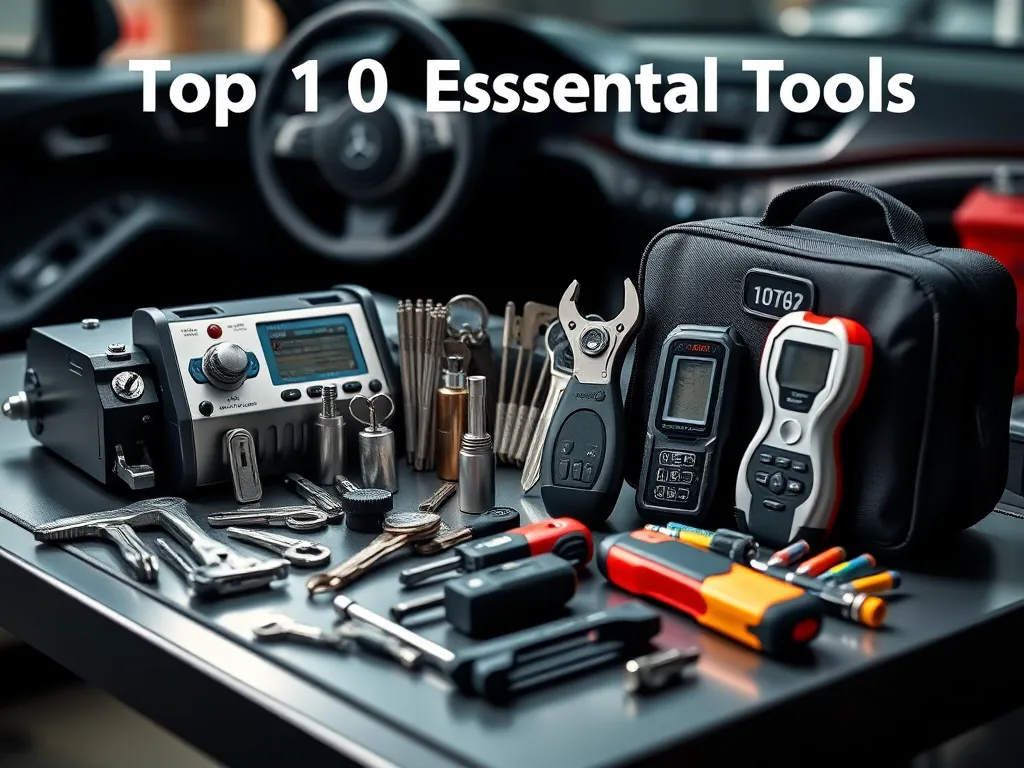Essential Tools: Top 10 for Automotive Locksmiths

Automotive Locksmithing: A Comprehensive Guide
Automotive Locksmithing is an essential service that focuses on the security of vehicles. As cars become increasingly advanced with technology, the role of automotive locksmiths has evolved to include a range of specialized skills and tools. This article provides an in-depth look at the field of automotive locksmithing, highlighting the tools, techniques, and training required to excel in this profession.
The primary function of automotive locksmithing is to assist vehicle owners with lockouts, key replacements, and security upgrades. With advancements in automotive technology, locksmiths are also required to handle modern locking systems, including transponder keys and electronic locks. This article will explore the various aspects of automotive locksmithing, enabling aspiring locksmiths and vehicle owners to understand the importance of skilled professionals in maintaining vehicle security.
Investing in high-quality key cutting machines ensures precision and efficiency in producing keys for various locks.
Automotive locksmithing is not just about unlocking vehicles; it involves a comprehensive understanding of different locking mechanisms and their applications. Locksmiths undertake rigorous training to become adept at manipulating locks and addressing various challenges, such as keys that are lost or damaged. Furthermore, automotive locksmiths are often called to help with security assessments, providing invaluable expertise to vehicle owners looking to safeguard their investments.
For both amateurs and professionals, mastering the use of lock pick sets can elevate your locksmithing skills significantly.
One of the key components of automotive locksmithing is the necessary tools for the trade. From lockout tools to diagnostic equipment, locksmiths must be equipped with a diverse range of instruments to address the varying needs of their clients effectively. This article delves into the essential tools and techniques utilized in automotive locksmithing, ensuring that professionals are prepared to tackle any situation that arises.
In summary, automotive locksmithing is a vital service that addresses the security needs of vehicle owners. With the continued evolution of automotive technology, the locksmithing profession is positioned to adapt and grow, offering new opportunities for those interested in pursuing a career in this field. Understanding the tools, techniques, and ongoing education required in automotive locksmithing will empower both locksmiths and car owners alike.
Lockout Tools: Essential Equipment for Quick Entry
Lockout tools are critical for automotive locksmiths, allowing them to gain entry to locked vehicles without causing damage. One common technique is the use of a Slim Jim, a thin strip of metal used to manipulate the locking mechanism through a gap in the vehicle's window. By understanding the anatomy of different car locks, locksmiths can utilize Slim Jims effectively to unlock a variety of vehicles.
Wedges and airbags are another set of lockout tools that locksmiths frequently use. By inserting a wedge into the door seam, locksmiths can create a gap wide enough to insert an inflatable airbag. This allows for gradual prying of the door, enabling safe access to the vehicle's interior without damaging the door frame or lock mechanism.
Long reach tools are essential for unlocking vehicles in situations where conventional methods are ineffective. These tools can be as simple as a long rod or as complex as specialized locking devices. By reaching through the vehicle's window to manipulate the lock or door handle, locksmiths can successfully resolve a lockout situation with minimum hassle for the vehicle owner.
Utilizing the right diagnostic tools for locksmiths can help identify issues quickly, improving service quality and customer satisfaction.
Key Cutting Equipment: Duplicating and Programming Keys
In automotive locksmithing, key cutting equipment is vital for producing duplicates of existing keys or creating new ones. Automated key cutting machines streamline the process, delivering precise cuts based on the specifications of the original key. These machines have revolutionized the key duplication process, allowing locksmiths to serve clients quickly and efficiently.
Manual key duplicators are also an essential part of a locksmith's toolkit, particularly for older vehicles that may not be compatible with automated machines. These devices require a skilled hand to ensure that the duplicate key operates smoothly within the lock. Understanding how to use manual duplicators remains a crucial skill for locksmiths, emphasizing craftsmanship in their work.
Transponder key programming tools are another important subset of key cutting equipment. As modern vehicles increasingly utilize transponder keys for enhanced security, locksmiths must be equipped with the necessary programming tools to create new keys that communicate with the vehicle's onboard computer system. Proficiency in transponder programming is essential for any automotive locksmith in today's market.
Diagnostic Tools: Understanding Vehicle Security Systems
Diagnostic tools play a significant role in automotive locksmithing, particularly when dealing with modern vehicles. OBD-II scanners allow locksmiths to read error codes and diagnose issues related to various vehicle systems, including the locking mechanism. This capability enables locksmiths to identify problems and execute informed solutions promptly.
Key programming software is another essential diagnostic tool that locksmiths utilize for modern vehicles equipped with advanced locking systems. This software enables locksmiths to program new keys, reset codes, and reprogram existing keys, ensuring they function correctly with the vehicle's electronic systems.
Remote key fob testers are invaluable diagnostic tools for automotive locksmiths. These devices can confirm whether a remote key fob is transmitting signals effectively and help diagnose issues with keyless entry systems. By utilizing remote key fob testers, locksmiths can troubleshoot and resolve problems related to vehicle access efficiently.
Lock Picking Tools: Mastering the Art of Entry
Lock picking tools are a fundamental part of automotive locksmithing, as they allow skilled locksmiths to gain entry to locked vehicles without damaging the locks. Tension wrenches are used in conjunction with picks to apply pressure to the lock while manipulating the pins inside. Mastering this technique requires practice and a thorough understanding of different lock designs.
Pick sets are essential for locksmiths, as they contain various picks designed for different types of locks. Each pick serves a unique purpose, whether it be to engage a specific pin or to unlock a certain locking mechanism. A well-rounded pick set allows locksmiths to tackle a wide range of locking systems effectively.
Bump keys are also part of the locksmith's arsenal. These specially crafted keys can be used to unlock locks by applying a sudden mechanical force, causing the pins to jump and allowing the lock to turn. While their use requires finesse and practice, bump keys are a valuable tool for automotive locksmiths when traditional methods prove unfruitful.
Security Assessment Tools: Evaluating Vehicle Safety
Security assessment tools are vital in helping automotive locksmiths evaluate the effectiveness of vehicle locking systems. Lock evaluation devices provide locksmiths with insight into the strength and vulnerabilities of various locking mechanisms, allowing them to recommend upgrades or replacements to enhance security.
Digital cameras are also utilized in security assessments, as locksmiths can document lock features and identify potential weaknesses in the vehicle's security. By capturing detailed images of locks and access points, locksmiths provide comprehensive information to vehicle owners about their security status.
Security audit tools enable locksmiths to conduct thorough evaluations of vehicle security systems. These tools assist in identifying any vulnerabilities in the locking mechanisms, guiding locksmiths in recommending preventative measures to enhance overall security against theft and unauthorized access.
Personal Protective Equipment (PPE): Safety First
Personal protective equipment (PPE) is critical for automotive locksmiths, ensuring their safety while working in potentially hazardous conditions. Safety gloves protect locksmiths from sharp edges and potential injuries when working with tools or inside vehicles, promoting a secure working environment.
Safety goggles are an essential part of PPE, as they safeguard the eyes from debris, chemicals, and other hazards encountered in the field. By wearing appropriate eye protection, locksmiths can work confidently, knowing their vision is protected during intricate tasks or when handling tools.
Knee pads are another essential piece of equipment for automotive locksmiths. When working on vehicles, especially when performing tasks that require kneeling, knee pads provide cushioning and support. By using knee pads, locksmiths can maintain comfort and reduce the risk of injury over prolonged work periods.
Workstations and Storage: Organizing the Workspace
Portable workbenches are invaluable for automotive locksmiths, allowing them to set up a workspace in various locations, whether at a job site or in their van. These workbenches can accommodate tools and equipment, enabling locksmiths to work efficiently while on the go.
Toolboxes are crucial for organized storage of locksmith tools. A well-organized toolbox allows locksmiths to quickly access the tools they need, reducing time spent searching for specific items and increasing overall productivity. Various compartments and organizers within a toolbox can help keep tools sorted by type and purpose.
Vehicle storage solutions for locksmith vans are also important for maintaining an organized workspace. Partitioning systems and shelving units can be installed in vans to ensure tools and equipment are securely stored during transit, preventing damage and making them easily accessible during jobs.
Software Tools: Streamlining Business Operations
Software tools have become increasingly important in automating various business processes for automotive locksmiths. Inventory management software allows locksmiths to track tools, equipment, and supplies, ensuring they always have the necessary items on hand to serve clients efficiently.
Customer relationship management (CRM) systems are essential for managing customer interactions and providing excellent service. These systems allow locksmiths to track client requests, schedule appointments, and maintain communication, fostering positive relationships and repeat business.
QuickBooks and similar accounting software help locksmiths manage their finances effectively. From invoicing clients to tracking expenses, accounting software streamlines financial management, allowing locksmiths to focus on providing quality service rather than getting bogged down in paperwork.
Training and Certification Tools: Building Expertise
Training and certification tools are vital for individuals interested in a career in automotive locksmithing. Online courses offer flexible learning opportunities, allowing aspiring locksmiths to gain foundational knowledge at their own pace and convenience.
Workshops provide hands-on training, allowing trainees to work alongside experienced locksmiths, gaining practical skills essential for success. These workshops often cover lock picking, key cutting, and security assessments, enabling students to apply their knowledge in real-world scenarios.
Resources for continuing education are crucial for automotive locksmiths looking to stay updated on the latest industry trends and technologies. Online forums, webinars, and conferences provide locksmiths with valuable information to enhance their skills and techniques throughout their careers.
Marketing Tools for Locksmiths: Attracting Clients
Marketing tools are essential for automotive locksmiths to build their brand and attract clients. Business cards and branding materials are fundamental for communicating professionalism and credibility. Effective branding helps locksmiths stand out in a competitive market, leaving a lasting impression on potential customers.
Website development for locksmith services is increasingly important. A professional website serves as a central point for clients to learn about services, request quotes, and read reviews. SEO optimization can help locksmiths attract new clients through search engines, increasing visibility in their local area.
Social media tools play a crucial role in promoting locksmith services. Platforms like Facebook, Instagram, and Twitter allow locksmiths to engage with potential clients, share helpful tips, and showcase their work. A strong social media presence can enhance brand recognition and foster trust with customers.
